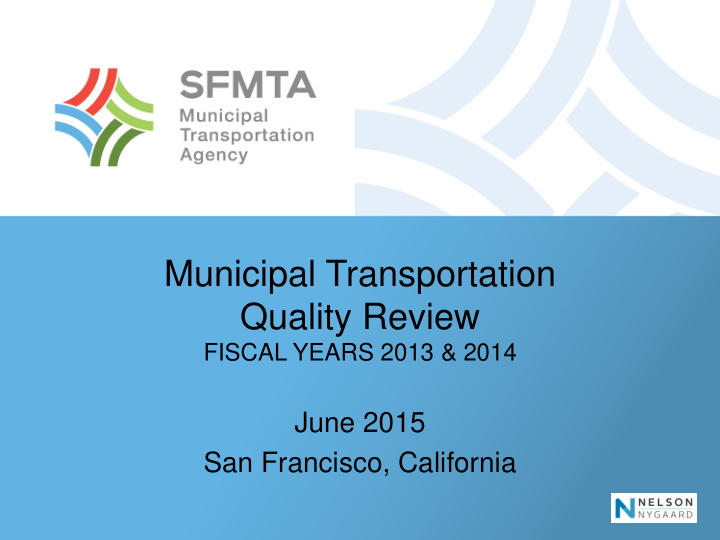



Municipal Transportation Quality Review FISCAL YEARS 2013 & 2014 June 2015 San Francisco, California
Introduction • This is the 7 th biennial Transportation Quality Review since they were mandated by Prop E in 1999 • This presentation covers two rounds: FY 2011-2012 and FY 2013-2014 • The review does not include the recent improvements in Muni performance during FY 2015, including: – Increased operator availability and level of service delivery – Upward trend in on-time performance – Increased vehicle reliability for Rubber Tire, LRV and Cable Car fleets
What is the Quality Review? • Audit of Muni data collection and reporting methods • Analysis of performance • Recommendations to improve both
Summary Findings – FY 2011-2012 • No major problems with data collection and reporting • Overall performance declined in FY11-12 due to vehicle constraints and increased ridership • Improvements observed in service delivery and vehicle reliability • Audit period covered the SFMTA’s transition to a new way of processing and reporting data, so no major changes were recommended
Summary Findings – FY 2013-2014 • No major problems with data collection and reporting • Overall performance remained stable, with improvements in customer security, employee safety, and vehicle reliability • No major changes to performance reporting recommended – focus on minor fixes and ongoing Agency coordination
Changes Since Last Quality Review • Adoption of FY 2013-2018 Strategic Plan: SFMTA leadership commitment to timely and transparent performance reporting • New “Performance Team” oversees Transtat, a business intelligence tool used for data visualization and reporting • New set of cohesive performance metrics, based on Strategic Plan goals/objectives and past Quality Review recommendations • Monthly Strategic Plan Metrics Reports offer meaningful data in an easily-understandable format
Performance Reporting • Only minor issues: – May and June 2014 data for metric 2.2.7, percentage of trips over capacity during AM peak, were misreported due to an internal error – the correction was not accompanied by a note explaining the change. – Data for metric 4.3.3, unscheduled absence rate of transit operators, may both under- and over-count “unscheduled” absences due to limitations in the source data
Performance FY 2013-2014 Audit Finding FY2015 Trend On-time performance fell short of 85% Charter goal – audit period high ▲ was 61.4% in April 2013 Service delivery (% of Scheduled Service Delivered) remained shy of ▲ 98.5% Prop E target on average, but occasionally exceeded the target month-to-month Bunching/gapping relatively constant: around 5.6% (% of trips w/ <2 min ▲ bunching) and 18% (% of trips w/ +5 min gaps) Ridership ▼ Ridership increased gradually, while the percentage of trips over capacity during the AM and PM peak hours decreased slightly Over capacity ▲
Performance FY 2013-2014 Audit Finding FY15 Trend Security: SFPD-Reported Muni-Related Crimes/100,000 Miles dropped 40% ▼ in November 2013 due to “surge” program Safety: workplace injuries declined, but collisions with and falls on board ▼ Muni vehicles gradually increased Reliability: Mean Distance Between Failure for buses increased steadily due ▲ to new fleet and improved preventative maintenance; MDBF for rail dropped slightly
General Recommendations • Ensure all new Agency recordkeeping and data management software use inter-compatible formats • Consider improvements to the Operations Central Control data management system • Expand public documentation of Strategic Plan Metrics Report metrics • To extent possible, consider reporting additional historic data in the monthly Metrics reports • Continue to ensure the accuracy and internal consistency of publicly reported data
Specific Recommendations 1.1.1 SFPD-Reported Muni-related Crimes/100,000 Miles • Continue coordination with Security, Investigations & Enforcement team to ensure compatibility b/w Transtat and any new SIE data management software • Revisit the performance target for this metric and modify as necessary – SIE staff suggest that tying target to ridership may be more meaningful 1.3.1 Muni Collisions/100,000 Miles & 1.3.3 Muni Falls on Board/100,000 Miles • Explore opportunities to streamline tracking and reporting in TransitSafe replacement software
Recommendations 2.1.1 Customer Rating: Overall Satisfaction • Work with Communications team to re-evaluate approach to customer surveys – Current approach has several limitations: “survey fatigue,” not yet geographically representative. 2.2.1 Percentage of Transit Trips with <2 Min Bunching or +5 Min Gaps on Rapid Network • Redefine metric to focus on ‘frequent’ services (i.e., 10 mins or less); provide full definition of metric on monthly reports 2.2.2 Percentage of On-Time Performance for Non-Rapid Network Routes • Redefine metric to focus on ‘infrequent’ services (i.e., more than 10 mins)
Recommendations 2.2.4 Percentage of On-Time Departures from Terminals • Consider a tighter internal definition of “on time” 2.2.7 Percentage of Trips Over Capacity During AM/PM Peak at Max Load Points • Consider differentiating between route types (i.e., ‘frequent’ services vs. Community Circulators) • Consider separate metric evaluating routes traveling in/out of downtown only
Recommendations 2.2.8 Mean Distance Between Failure • Cable Car: Formalize “chargeable” definitions • Rubber Tire: Ensure that maintenance’s Enterprise Asset Management system will work with Transtat, and enable access to individual, transaction-level incident detal • Light Rail/Streetcar: Enable access to individual, transaction-level incident detail 2.2.11 Ridership (Average Weekday Rubber Tire, Faregate Entries) • Consider reporting annual ridership data by mode
Recommendations 3.2.1 Estimated economic impact of Muni service delays • Update underlying wage data and include full methodology in public reporting 4.3.3 Unscheduled absence rate by employee group (Transit operators) • Review/simplify Trapeze coding system for increased clarity about “absences” • Institute additional metric(s) to track attendance Agencywide
Summary • Performance – Relatively stable, with improvements in key areas (customer security, employee safety, and vehicle reliability) • Recommendations – Minor tweaks and suggestions for continued usefulness, efficacy, and transparency of performance reporting – Ensure SFMTA keeps up the good work!
Recommend
More recommend